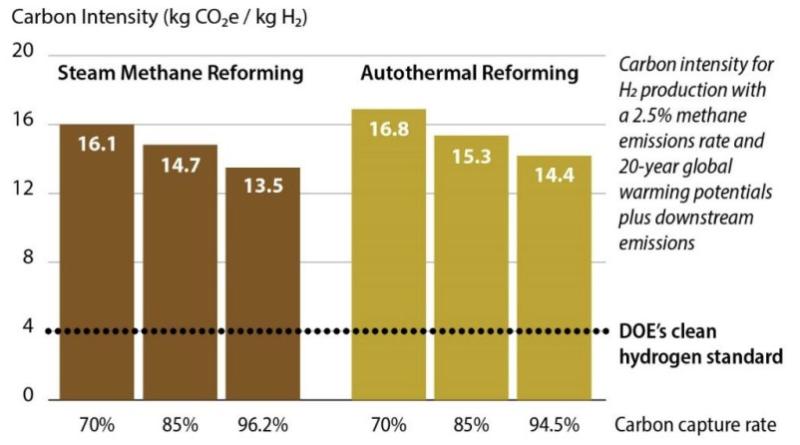‘Blue’ hydrogen slammed as dirtier than natural gas

Hydrogen produced from steam-methane reforming (SMR) and carbon capture and storage (CCS), or ‘blue’ hydrogen, may be as polluting as burning natural gas, studies say.
In the last few years, governments and companies have developed strategies to build a clean hydrogen economy by removing damaging emissions from hydrogen already in production and increasing hydrogen production for uses as varied as transport, electricity storage, and heating.
What counts as ‘clean’, however, is hotly debated and the oil and gas industry’s preferred method of SMR with CSS could be costly waste of time and energy, recent studies from researchers at Cornell University and the Institute for Energy Economics and Financial Analysis (IEEFA) say.
Today, over 95% of hydrogen produced to meet the global demand of around 94 million tons (Mt) a year is manufactured using fossil fuels with SMR (without CCS), data from the International Renewable Energy Agency (IRENA) shows.
The method produces ‘grey’ hydrogen and large amounts of carbon dioxide, while ‘green’ hydrogen from electrolyzers, powered by clean electricity, makes up just 4% of the total.
If all projects in the pipeline were realized, by 2030 the production of low-emission hydrogen could reach 16-24 Mt/yr, with 9-14 Mt from electrolysis and 7-10 Mt on fossil fuels with CCS, according to the International Energy Agency (IEA).
How green is blue?
The greenhouse gas footprint of hydrogen produced from SMR and CCS (‘blue’) is more than 20% greater than burning natural gas or coal for heat and some 60% greater than burning diesel oil for heat, according to the Cornell University study ‘How green is blue hydrogen?’.
The study was released in 2021, but one of the two authors, biogeochemist and ecosystem scientist at Cornell University Robert Howarth, says his stance has only hardened in the last couple of years.
“Over time, I've become even more skeptical of hydrogen and carbon capture. There are so many more straightforward ways to deal with our energy transitions, and I view it as a pretty desperate effort on the part of the oil and gas industry to keep their business model going,” Howarth says.
Large companies in the oil and gas industry are working hard to lead the field of hydrogen production, with oil-rich countries like Saudi Arabia building giant hydrogen hubs in the desert, and oil majors such as Shell, Repsol, and BP rolling out their own strategies.
While CO2 emissions are 9-12% lower through SMR with CCS than without (assuming a 3.5% emission rate of methane from natural gas and a 20-year global warming potential (GWP)), the criticism centers on the release of fugitive methane.
At Argonne National Laboratory, the home of the GREET full life-cycle model which aims to fully evaluate the environmental impact of new fuels such as hydrogen, researchers say CCS is 95% effective in reducing CO2 emissions from natural gas hydrogen plant, there is an existing infrastructure to build upon, and natural gas is abundant and cheap in the United States.
“When you look at the environmental side, we also try to understand it from a broader sustainability perspective, which is not only environmental but also economic,” says ANL Senior Scientist and Group Leader, Electrification and Infrastructure Amgad Elgowainy.
Challenging assumptions
The GREET assumption that just 1% of the methane being used to produced hydrogen will be emitted into the atmosphere between the well and the production facility is far less than recent peer-reviewed analyses that have used airplanes and satellite emission surveys, according to the IEEFA study ‘Blue Hydorgen: Not Clean, Not Low Carbon, Not a Solution.’
GREET also focuses on the 100-year GWP of methane, which understates the gas’ environmental impact on global warming since its 20-year GWP is more than 80 times that of CO2.
By using 20-year GWP and 2.5% methane emission rate, the carbon intensity of hydrogen through SMR and CCS jumps to between 10.5 and 11.4 kg of CO2 per kilo of hydrogen compared to the 4 kg of CO2 per kilo of hydrogen clean production standard established by the Department of Energy (DOE) and Congress, the study finds.
A well-to-production-facility analysis also ignores downstream emissions from the produced hydrogen and the generation of the electricity need to compress, store, and transport the hydrogen to the user, it says.
“The GREET model reflects near optimal case set of assumptions, the one that would produce the lowest carbon intensity for ‘blue’ hydrogen from natural gas,” says David Schlissel, lead author of the paper and IEEFA Director of Resource Planning Analysis who says the conclusions of the GREET model are DOE and Congress mandated.
Big picture
ANL’s Elgowainy notes that they look at both 20-year and 100-year GWP, but the latter is the more universally agreed metric in regulations that target greenhouse gas emissions reduction.
The model has examined different levels of methane emission and 1% is considered neither too high nor low of an assumption based on most recent reported data in the United States, he says.
Methane emissions from top-down studies (from airplanes or satellites) rather than bottom-up (studying leaks at the source of the process) are useful data points, but are not necessarily more representative, Elgowainy says.
“If you want to decarbonize fast, using the ideal method you need to think how to stage decarbonization to be sustainable. These are considerations that we need to think about for the big energy picture,” he says.
However, Schlissel’s and Howarth’s studies suggest that the ‘blue’ hydrogen route may result in billions of dollars being spent on an extraction method that will end up being just as contaminating as fossil fuel energy production and, due to some low-ball assumptions at the industry’s conception, lock in the world’s reliance on fossil fuels for decades to come.
“If you believe that when ‘blue’ hydrogen is found to be very dirty and high carbon the oil and gas industry is going to give up the massive profits they're going to make from it, then I've got a bridge from Manhattan to Brooklyn I'd like to sell you,” says Schlissel.






